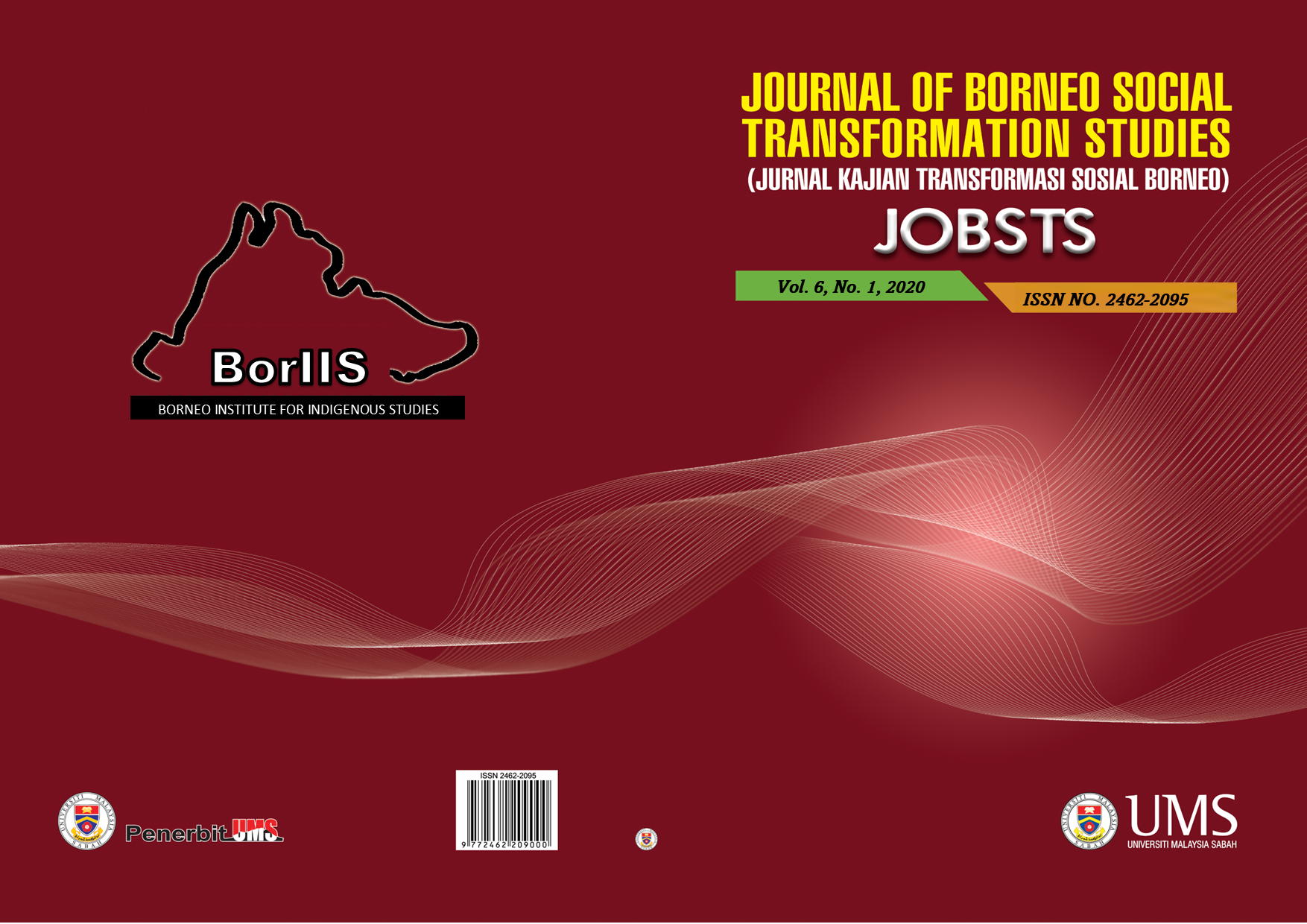PENGARUH SOSIOBUDAYA ORANG ASAL TERHADAP TINGKAH LAKU PENJAGAAN KESIHATAN: SATU TINJAUAN LITERATUR
THE SOCIO-CULTURAL INFLUENCE OF INDIGENOUS PEOPLES ON HEALTH CARE BEHAVIOR: A LITERATURE REVIEW
DOI:
https://doi.org/10.51200/jobsts.v6i1.2798Keywords:
Elemen Sosiobudaya, Geografi Kesihatan, Orang Asal, Tingkah Laku Penjagaan KesihatanAbstract
Penyelidikan Geografi Kesihatan sebagai subdisiplin dalam Geografi Manusia mula berkembang seiring dengan penggunaan kaedah kualitatif yang semakin popular menjelang tahun 1990-an. Pengkajian Geografi Kesihatan adalah berfokuskan kepada pemberian makna tempat dan pengaruh persekitaran kepada kesihatan. Pendekatan ini berkontradiksi dengan pendekatan Geografi Perubatan yang melihat tempat hanyalah sebagai ‘kanvas’ dimana peristiwa berlaku. Pemberian makna tempat dalam kajian Geografi Kesihatan menunjukkan bahawa tempat bukan hanya dicirikan oleh sifat fizikal malah juga dicirikan oleh sifat sosiobudaya. Justeru, dalam memahami tentang hasil kesihatan disesebuah tempat, ciri budaya turut perlu diambil kira. Oleh itu, dalam artikel ini elemen sosiobudaya yang mempengaruhi tingkah laku orang asal dalam penjagaan kesihatan akan diulas dengan lebih lanjut. Kepercayaan kesihatan dalam kalangan orang asal didapati adalah bersifat kolektif yang meliputi kesihatan fizikal dan mental, hubungan dengan nenek moyang, komuniti dan alam semula jadi. Manakala elemen sosiobudaya yang mempengaruhi tingkah laku penjagaan kesihatan dalam kalangan orang asal adalah pelbagai seperti batasan bahasa, pendidikan, jaringan keselamatan sosial, pengaruh gender dan sebagainya. Elemen sosiobudaya tersebut didapati menyebabkan halangan akses penjagaan kesihatan dalam kalangan orang asal. Maka itu, intervensi yang berkesan dalam mengatasi halangan tersebut perlulah bersifat holistik dan melibatkan pendekatan transdisiplin bagi meningkatkan keyakinan dan penggunaan orang asal terhadap perkhidmatan penjagaan kesihatan.
Health Geography research as a subdiscipline in Human Geography began to grow in line with qualitative methods that became increasingly popular by the 1990s. The study of Health Geography is focused on giving meaning to places and the influence of the environment on health. This approach contradicts the Medical Geography approach, which sees the place only as a 'canvas' where events occur. The definition of place in the study of Health Geography shows that place is not only characterized by physical properties but also characterized by socio-cultural properties. Therefore, in understanding the health outcomes of a place, a place's cultural characteristics should be taken into account. Thus, in this paper, the socio-cultural elements influencing indigenous behavior in health care will be reviewed further. Health beliefs among indigenous peoples were collective in nature, covering physical and mental health, ancestral relationships, community, and nature. At the same time, the socio-cultural elements that influence health care behavior among indigenous people are various such as language limitations, education, social security networks, gender influences, and so on. These socio-cultural elements were found to cause barriers to access to health care among indigenous peoples. Therefore, effective interventions in overcoming these barriers must be holistic and involve a transdisciplinary approach to increase indigenous people's confidence and use in healthcare services.
References
Abd. Hakim Mohad. (2014). Spiritual journey of Murut Tahol in Sabah and its effect to their headhunting practice. International Journal of Social Science and Humanity, 4(6): 426-429.
Aniza, I., & Norhayati, M. (2016). Barriers to health promotion for indigenous communities: Lessons for Malaysia. Malaysian Journal of Public Health Medicine, 16(1), 6-14.
A.S. Hardy Shafii, Solehah Ishakb, Hazman Hassanc, Mohamed Ghouse, Nasuruddin & Mumtaz Beguma. (2016). Babalian and Community Rituals of Dusun Tatana Ethnic in Sabah, Malaysia: A Preliminary Study. The European Proceedings of Social and Behavioral Sciences.
Atwine, F., Hultsjö, S., Albin, B., & Hjelm, K. (2015). Health-care seeking behaviour and the use of traditional medicine among persons with type 2 diabetes in south-western Uganda: A study of focus group interviews. Pan African Medical Journal, 20, 1–13.
Australian Bureau of Statistics. (2016). National Aboriginal and Torres Strait Islander Social Survey, 2014–15 (Catalog no. 4714.0). Commonwealth of Australia.
Australian Institute of Health and Welfare. Indigenous Australians Data; 2015. Diakses daripada http://www.aihw.gov.au/.
Balgir, R.S. (2011). Genetic Disease Burden, Nutrition and Determinants of Tribal Health Care in Chattisgarh State of Central-East India: A Status Paper. Online Journal of Health and Allied Sciences. 10(1), 1-7.
Balgir, R.S. (2006). Tribal Health Problems, Diseases Burden and Ameliorative Challenges in Tribal Communities with special emphasis on Tribes of Orissa. Tribal Health: Proceedings of National Symposium. Regional Medical Research Centre for Tribals, Indian Council of Medical Research. 161-176.
Cunningham, J. (2002). Diagnostic and therapeutic procedures among Australian hospital patients identified as indigenous. Medical Journal of Australia, 176(2), 58-62.
Commonwealth of Australia. (2013). National Aboriginal And Torres Strait Islander Health Plan 2013-2023.
Colonius Atang. (2014). Unsur-Unsur Sosiobudaya dalam geografi kesihatan: Satu Kajian Tingkah Laku menghadapi Kanser dalam kalangan Orang Melayu di Pulau Pinang dan Kedah. Tesis Doktor Falsafah. Universiti Sains Malaysia.
Davy et al. (2016). Access to primary health care services for Indigenous peoples: A framework synthesis. International Journal for Equity in Health (2016) 15, 163.
DiGiacomo M, Davidson PM, McGrath SJ, Dharmendra T, Thompson SC. (2012). Cancer in Aboriginal and Torres Strait Islander peoples: an Evidence Check rapid review brokered by the Sax Institute (http://www.saxinstitute.org.au) for the Cancer Institute NSW, 2012.
Fung, J.M. (2003). The Muruts: Spiritual world, rituals and shamanism. Journal of Sabah Society 20, 15–23.
United Nations Human Rights. 2013. Indigenous Peoples and the United Nations Human Rights System.
Kahissay, M. H., Fenta, T. G., & Boon, H. (2017). Beliefs and perception of ill-health causation: A socio-cultural qualitative study in rural North-Eastern Ethiopia. BMC Public Health, 17(1), 1-10.
Khairul, Z. M., & Tugang, N. (2016). Perubahan Objek Tajau dalam Budaya Iban di Sarawak. Universiti Malaysia Sabah. Diakses daripada
https://www.academia.edu/32705807/Perubahan_Objek_Tajau_Dalam_Budaya_Iban_di_Sarawak
Latunji, O. O., & Akinyemi, O. O. 2018. Factors Influencing Health-Seeking Behaviour Among Civil Servants in Ibadan, Nigeria. Annals of Ibadan Postgraduate Medicine, 16(1), 52-60.
Li, J. (2017). Cultural barriers lead to inequitable healthcare access for aboriginal Australians and Torres Strait Islanders. Chinese Nursing Research, 4(4), 207–210.
Low Kok On. (2003). Membaca Masa Silam KadazanDusun berdasarkan Mitos dan Legenda. Tesis Doktor Falsafah, Universiti Malaysia Sabah.
Mackian, S. (2003). Health Systems Development Programme A review of health seeking behaviour : problems and prospects. Health Systems Development, 27.
Michael, E., & Chuen, E.M. (2012). Education and Health Awareness Among Indigenious People: A Study in Perak, Malaysia. ARPN Journal of Science and Technology, 2(8), 1-5.






